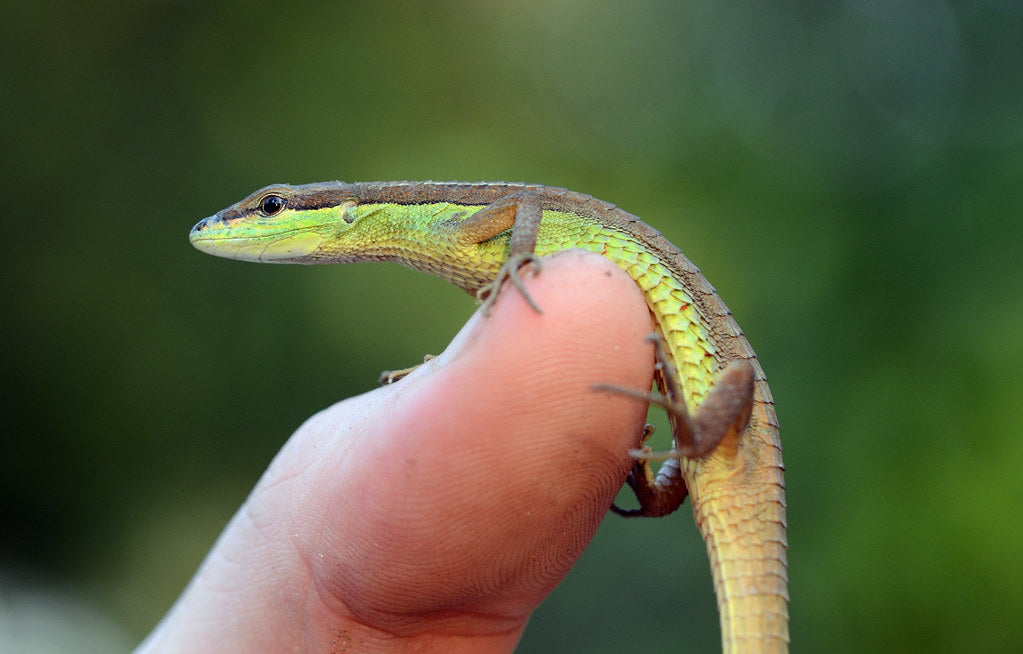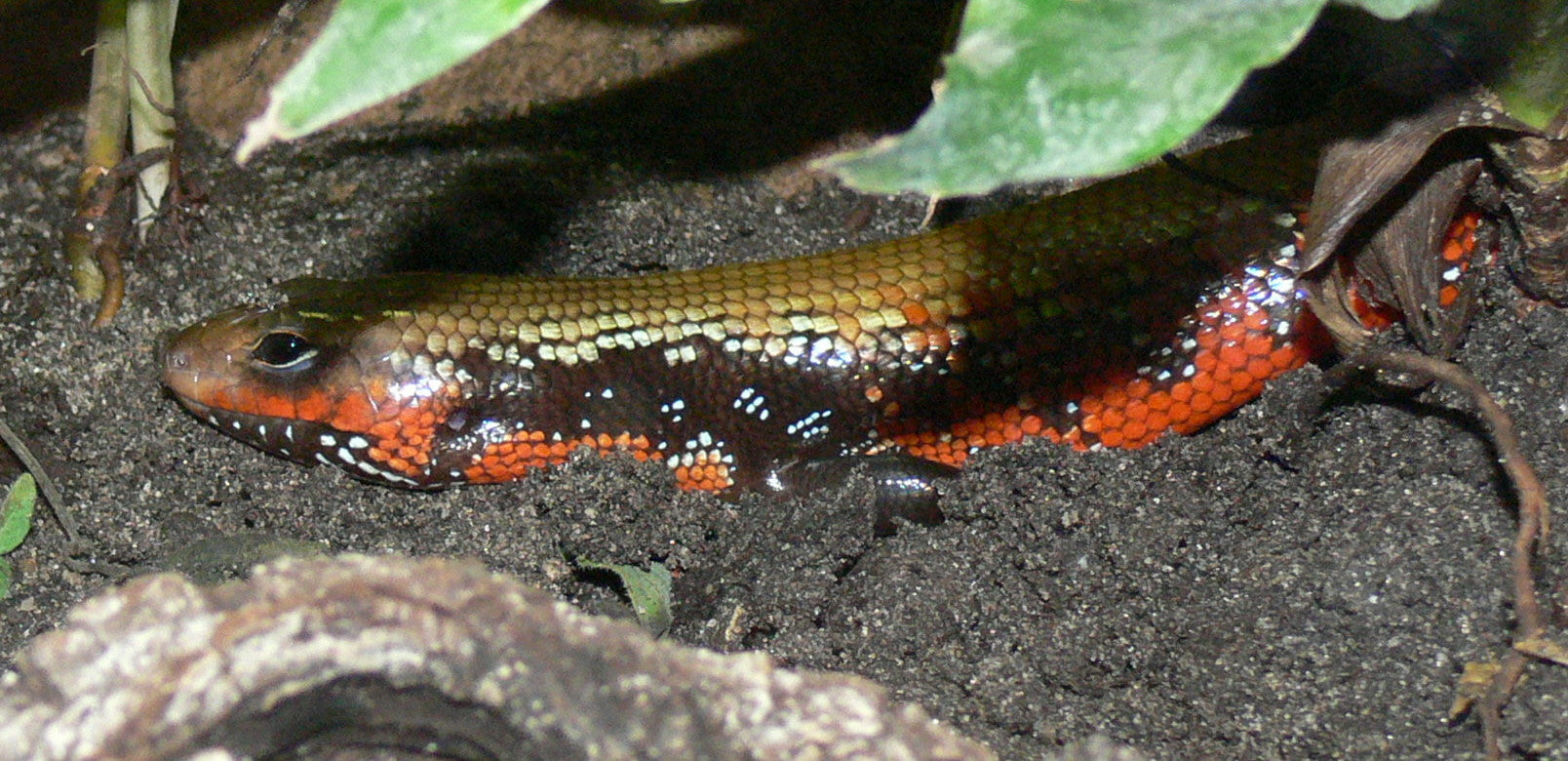Emerald tree skinks (Lamprolepis smaragdina) are small, diurnal, arboreal lizards native to southeast Asia, particularly the Philippines and Indonesia. They can usually be found climbing up and down tree trunks in tropical forest, spending little time on the ground.
Emerald tree skinks are typically 8.5-10” long, with a sharply tapered head, large black eyes, smooth scales, and long toes. They are traditionally bright green in color, but may have black speckling or be entirely or partially brown. Some individuals are entirely green except for their hind limbs, which are brown with white spotting.
These skinks are intermediate-level pet reptiles due to their low handleability and sensitivity to poor husbandry. With good care, they can be expected to live at least 7 years.
How much space do emerald tree skinks need?
Emerald tree skinks are active lizards who need plenty of space for running around and climbing. A single skink should be housed in absolutely no smaller than a 18” x 18” x 36” terrarium, but larger is always better!
Cohabitation (keeping multiple emerald tree skinks together) tends to work well for this species, however, it is not required for their wellbeing. Do not house males and females together without the intent to breed.
Do emerald tree skinks need UVB?
Emerald tree skinks require exposure to UVB light for their survival, and also benefit from bright plant grow lights in their environment. Lights should be on for 12 hours/day and turned off at night.
The best UVB bulbs for emerald tree skinks are:
- Arcadia ShadeDweller Kit — 6” above basking branch
- Arcadia T5 HO 6%, 22” — 8” above basking branch
The UVB bulb should be housed in a reflective Arcadia or Vivarium Electronics fixture, roughly the same length as the enclosure, and placed close to the heat lamp. UVB is blocked by glass and plastic, so you can’t give your skink UVB by placing its terrarium in front of an open window.
As day-active lizards, emerald tree skinks also benefit from a 6500K LED or T5 HO fluorescent grow light to provide extra bright light in the enclosure and better simulate the effects of the sun. This is particularly necessary if you want to have live plants as part of the enclosure.
What basking temperatures do emerald tree skinks need?
Emerald tree skinks should have a basking temperature of 95°F, as measured by a digital probe thermometer with the probe placed on the basking surface. There should be a cooler area on the opposite side of the enclosure that stays between 75-85°F.
Provide heat for your skink by imitating the sun with a halogen heat lamp placed on one side of the enclosure. Do not use ceramic heat emitters (CHEs), red bulbs, or blue bulbs, as these are not as effective. The basking surface should be a sturdy branch.
The heat source should be turned off at night. Nighttime temperatures can drop as low as 68°F, but should be no warmer than 77°F.
What humidity levels do emerald tree skinks need?
Emerald tree skinks need a high humidity environment for best health. Average humidity should be around 70% during the day, rising to near 100% at night. You can monitor humidity levels with a digital probe hygrometer with the probe in the middle of the terrarium.
Misting your skink’s enclosure with a sprayer first thing in the morning and again in the evening will help create the right humidity levels. It also provides an important source of drinking water!
What substrate is good for emerald tree skinks?
Substrate covers the floor of your skink’s terrarium and helps make the enclosure more attractive, but it also helps maintain humidity. It’s ideal to use a substrate that imitates the “substrate” that the reptile naturally lives on in the wild. For emerald tree skinks, that means it should resemble tropical soil. It should have small particles and hold moisture well.
We recommend the following substrates for emerald tree skinks:
Layering clean, chemical-free leaf litter on top of the substrate can also help with humidity.
Substrate should be at least 2” deep and completely replaced every 3-4 months. Remove poop and urates daily, along with contaminated substrate.
What décor can you use in an emerald tree skink terrarium?
It’s terribly boring for a lizard to be stuck in an enclosure with nothing in it except substrate and food/water bowls. It doesn’t matter how big the enclosure is if you don’t put things in it for your pet to use and interact with.
At bare minimum, you will need a branch for your skink to climb and bask on and some live or artificial foliage for it to hide in. However, it’s best to include other items, such as:
- branches
- vines
- climbing rocks
- ledges
- textured backgrounds
- live or artificial plants
What do emerald tree skinks eat?
Emerald tree skinks are primarily insectivorous, which means that they need to eat insects (preferably live) in order to get the nutrition that their bodies need. How often they need to eat depends on age: Juveniles should be fed daily but fully-grown adults can be fed only every other day. Offer as many insects per feeding as the skink will eat within about 5 minutes.
Feeder insects for emerald tree skinks: dubia roaches, discoid roaches, crickets, hornworms, mealworms, darkling beetles
As an occasional treat, you can offer your skink some crested gecko food.
Supplements
You will also need calcium and vitamin supplements to prevent your skink from developing a deficiency. We recommend Repashy Calcium Plus LoD, lightly dusted on all of your pet’s feeder insects.
Water
Although your skink will get most of its drinking water from daily mistings, it’s a good idea to also provide a wall-mounted water dish. Change the water daily and scrub the bowl with a reptile-safe disinfectant weekly, or whenever it becomes soiled.
Do emerald tree skinks like to be handled?
Few reptiles actually “like” to be held, and emerald tree skinks aren’t one of them. Instead of interacting with your pet by holding it, try hand-feeding it instead with a pair of feeding tweezers.
*This care sheet contains only very basic information. Although it’s a good introduction, please do further research with high-quality sources to obtain additional information on caring for this species.
"Emerald Tree Skink (Lamprolepis smaragdina)" by hape662 is licensed under CC BY 2.0




Leave a comment
This site is protected by hCaptcha and the hCaptcha Privacy Policy and Terms of Service apply.